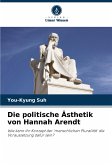Hannah Arendt's posthumous fame is only natural because she opened a new chapter in political philosophy by shedding fresh light on the relationship between the vita activa and the vita comtemplativa. As 'Judging,' the third part of The Life of the Mind was left unwritten, not a few people have so far been trying to expound her political thought in ingenious ways. Here is yet another theoretical attempt to redefine it in terms of 'political aesthetics' and how is it to be properly done? The discipline of aesthetics can be characterized by three distinct components; an aesthetic sense, an aesthetic method of thinking, and an aesthetic regime and on this basis I single out conscience, Socratic critical thinking, and the Arendtian Archimedean point for her political aesthetics. Moving on to map out a typology of human plurality consisting of HP-I, HP-II, HP-III, HP-IV, and HP-V, I come up with a conclusion that those politically insignificant people of the HP-V can be invited to theHP-IV in the name of social justice. This is probably what Hannah Arendt meant when she signaled a call for a new political philosophy and what her political aesthetics can deliver to us today.
Bitte wählen Sie Ihr Anliegen aus.
Rechnungen
Retourenschein anfordern
Bestellstatus
Storno








